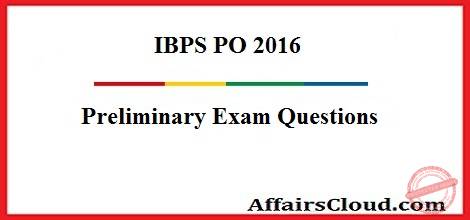Dear Aspirants,
Some of the questions asked in IBPS PO Preliminary Exam 16/10/16(All Shifts) are listed below. If you have any more questions from the exam, then kindly share it in the comment section.
Follow this page.. We’ll update more Questions & thanks to all readers for sharing…
Number Series:
- 12 19 35 59 90 ?
- 4 10 27 112 555 ?
- 16 7 5 6 16 ?
- 19 23 14 30 5 ?
- 15 22 36 64 ? 232
- 12 19 35 59 90 ?
- 22 10 8 12 40 ?
- 6 14 39 160 795 ?
- 29 20 36 11 ?
- 18 23 36 56 82 ?
- 13 21 37 69 ? 261
- 11 24 44 70 101 ?
- 14 25 47 91 ? 355
- 5 12 33 136 675 ?
- 28 32 23 39 14 ?
- 18 8 6 8 22 ?
- 20 24 15 31 6 ?
- 14 6 4 4 8 ?
- 11 20 38 74 ?
- 15 21 36 65 101 ?
Parajumble – Answer:
Carbon sinks, 70% of forest cover, powered almost entirely by Mountain streams – Bhutan is a poster child for green living.
It is the only country in the world that is carbon negative, Which means it produces more oxygen than it consumes.
So far, so good. But then, two things happened.
One, India and China got richer
Bhutan, sandwiched between the two most populous nations on Earth, suffers for their sins.
Glaciers are beginning to melt, flash floods and heavy rains—and even droughts—are common, and temperatures are climbing
Cloze Test:
1. Big ideas come from tackling big problems. When one is confronted with an overwhelming task, it is natural to try to break it down into manageable pieces. Business jargon is full of phrases about that, like manageable sizes and low-hanging fruit. Meaning they have their place, but in the repertory of management practice, they should share their place with bold approaches to big challenges, yet in smaller doses. Much of todays most valuable knowledge came from wrestling with such issues. The most complicated workplace in the middle of the last century and even today remains the large and often unwieldy public sector organisations. Drawn to its complexity were Peter F. Drucker, W. Edwards Deming, and Taiichi Ohno, among others. The work they and their disciples did, applied to industry after industry, is the basis of the best that we know about their operations, managing people, innovation.
2. In the approximately eight years since the book Nudge, by Richard Thaler and Cass Sunstein, came out, nudges have become a widely used consumer influence strategy.Nudge marketing refers to deliberately manipulating how choices are presented to consumers. Its goal is to influence what consumers choose, either to steer them toward options that the marketer believes are good for them or simply to stimulate purchases and increase sales.
For example, a supermarket places plastic mats with huge arrows marked “Follow the green arrow for your health” pointing shoppers toward the produce aisle. Within two weeks, produce purchases increase by 9%. A company automatically enrols new employees in its retirement savings plan unless they opt out. Enrolment in the plan rises from 60% to 95%. A restaurant lists a fish entree at a clearly overpriced $35 on its menu. It is not interested in selling the entree; the fish is there as a decoy to make other, more profitable items appear attractive. Over a decade of behavioral economics research shows that such nudges are effective in influencing consumer behaviors. Many nudges have virtuous effects, encouraging consumers to donate their organs, reduce their consumption of energy, and save more money. However, not everything about nudge marketing is rosy. In their enthusiasm, marketers have overlooked some fundamental concerns about using nudges. A company that doesn’t understand these minefields could adversely affect its marketing. Nudges that are poorly thought out could be ticking time bombs waiting to explode and damage the company’s reputation and credibility among its loyal customers.
Syllogism:
Statements:
Some Chairs are tables
Some tables are beds
No bed is furniture
Conclusions:
All tables can never be furniture
Some Chairs are furniture
Some beds are chairs
No bed is chair.
Blood Relation:
A is the brother of B. B is the son of C. C is married to D. D is the son of E. E has only one daughter F.
1. If G is son-in-law of E, then how G related to F?
Error Spotting:
1. Researchers had long been studying(1)/ a phenomenon called stress cardiomyopathy.(2)/ or broken-heart syndrome, which(3) almost always lead to the dreaded irregular heartbeat(4)/ No Error(5)
2. Though the original home of the peach(1)/is China, where they have still wild peaches(2)/cultivation of the same spread via Kashmir(3)/In India to Persia and to rest of the World.(4)/ No Error(5).
Ranking:
A, B, C, D, E and F of different lengths. E is shorter than B and D, but shorter than F. E is not the shortest. F is of 13 cm and second shorter is 4 cm.
Note: All have lengths in whole number.
If B is of 5 cm, then which is true?
If F + A = 23, then A + E = ?
Puzzle
A B C D E F G And H sitting in linear straight line some facing north and other south, E is to the fourth G. G is sitting immediate to the person sitting at one of the extreme ends.C is facing south. Two persons are sitting Between E and D. B is to the immediate left of D. Persons sitting at the end are facing the same direction. C and F are sitting at the end. Both the neighbour of B faces opposite direction. A is sitting 2nd left of H. H is immediate right of F. E and B are facing the same direction as F.





